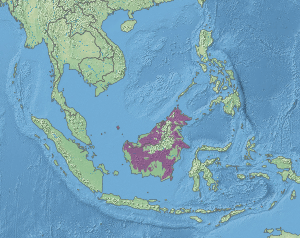Borneo lowland rain forests
The Borneo lowland rain forests is an ecoregion, within the tropical and subtropical moist broadleaf forests biome, of the large island of Borneo in Southeast Asia.[2] It supports approximately 15,000 plant species, 380 bird species and several mammal species. The Borneo lowland rain forests is diminishing due to logging, hunting and conversion to commercial land use.
| Borneo lowland rain forests | |
|---|---|
 Map of the Borneo lowland rain forests ecoregion | |
| Ecology | |
| Realm | Indomalayan |
| Biome | tropical and subtropical moist broadleaf forests |
| Borders | List
|
| Geography | |
| Area | 425,124 km2 (164,141 sq mi) |
| Countries | Brunei, Indonesia and Malaysia |
| Conservation | |
| Conservation status | vulnerable |
| Protected | 33,473 km² (8%)[1] |
Location and description
The World Wildlife Fund has divided Borneo into seven ecoregions: five areas of lowland forest; the central Borneo montane rain forests; and the Kinabalu montane alpine meadows. The lowlands are distinguished by climate (as the eastern side of the island is drier) or separated by the large Kapuas River and Barito River, which prevent animals and reptiles from spreading freely around the island.
The other lowland ecoregions, in addition to the Borneo lowland rain forests, are:
- Borneo peat swamp forests
- Sundaland heath forests
- Southwest Borneo freshwater swamp forests
- Sunda Shelf mangroves.
The Borneo lowland rain forests described in this article consist of all lowland areas not clearly in one of the above categories. They cover an area of about 165,100 square miles (427,500 km2), parts of which lie in all the political territories of the island: Kalimantan (Indonesia), Sarawak and Sabah (Malaysia) and Brunei. The Natuna Islands to the northwest are also part of the ecoregion.[3]
Climate
Lowland Borneo has a stable climate, with monthly rainfall exceeding 8 inches throughout the year and a temperature range of more than 18 °C.
Flora
The lowlands of Borneo are home to the richest rainforest in the world. The climate provides an ideal growing environment for approximately 10,000 species of plant (more than in the whole continent of Africa). Among these are some 2,000 orchids and 3,000 trees, including 267 [Dipterocarpaceae] tropical rainforest trees, of which 155 are endemic to Borneo. This makes the island the center of the world's diversity for dipterocarps. Plants include five species of the strong-smelling parasite Rafflesia, one of which, Rafflesia arnoldii, has flowers over a metre wide, making it the world's largest flower. The limestone uplands of the Sangkulirang Peninsula and Sarawak support their own particular plant communities, as do the Labi Hills on the Brunei-Sarawak border.
Fauna
The wildlife of this ecoregion consists of a large number of forest animals ranging from the world's smallest squirrel, the least pygmy squirrel, to the largest land mammal in Asia, the Asian elephant. It includes the critically endangered Sumatran rhinoceros, the endangered and iconic Bornean orangutan, twelve other species of primate, Bornean bearded pigs and Bornean yellow muntjac deer. The primates of Borneo are: three apes (Bornean orangutan, Müller's Bornean gibbon and Bornean white-bearded gibbon), five langurs, the southern pig-tailed macaque, the long-tailed macaque, Horsfield's tarsier (Tarsius bancanus), the Sunda slow loris (Nycticebus coucang) and the endangered proboscis monkey (Nasalis larvatus). There are no tigers on Borneo; carnivores include the endangered Sunda clouded leopard (Neofelis diardi), the sun bear (Helarctos malayanus), the otter civet (Cynogale bennettii), and several other mustelids and viverrids.
The 380 species of birds include eight hornbills, eighteen woodpeckers and thirteen pittas. There are nine near-endemic and two endemic birds; the black-browed babbler (Malacocincla perspicillata) and the white-rumped shama (Copsychus stricklandii). Among the rich variety of reptiles and amphibians are crocodiles and the earless monitor lizard (Lanthanotus borneensis). The sounds of the forest vary from day to night as different combinations of these birds and animals emerge to roam and feed.
Biogeography
During the Pleistocene glacial epoch, all of Borneo, Java, Sumatra, and mainland Indochina were part of the same landmass, called Sundaland. This allowed plants and animals to migrate from one region to the next. Now Borneo is separated from the Malay Peninsula and the other islands, but still shares much of the same plant and animal diversity, while less of the Borneo wildlife is to be found further east in Sulawesi.
Threats and preservation
Logging and conversion of natural forests to rubber, oil palm and industrial timber plantations and for small-scale farming have given rise to significant deforestation in recent decades. In 1982–83 and again in 1997–98, forest fires in Kalimantan cleared around 25,000 km2 each time for oil palm planting. Further threats in Sabah come from exploration for oil and coal in the Maliau Basin and the draining of the wetlands on the Klias Peninsula. In 2001, the World Wildlife Foundation forecast that "If the current trend of habitat destruction continues, there will be no remaining lowland forests in Borneo by 2010."[2] Although this forecast has not been fulfilled, in 2008 the IUCN Red List reported a 2005 prediction that "forest cover on the island of Borneo, if current deforestation rates continue, is projected to decline from 50% to less than one-third by 2020".[4]
Large nature reserves in Borneo include:
- In Kalimantan: Gunung Palung, Betung Kerihun, Kutai, Pleihari Martapura Wildlife Reserve and Kayan Mentarang National Parks.
- In Sabah: Danum Valley Conservation Area and Tabin Wildlife Reserve.
See also
- Mammals of Borneo
- List of ecoregions in Indonesia
- List of ecoregions in Malaysia
References
- Eric Dinerstein, David Olson, et al. (2017). An Ecoregion-Based Approach to Protecting Half the Terrestrial Realm, BioScience, Volume 67, Issue 6, June 2017, Pages 534–545; Supplemental material 2 table S1b.
- "Borneo lowland rain forests". Terrestrial Ecoregions. World Wildlife Fund. Retrieved 11 June 2011.
- "Ecoregions 2017" interactive map. Resolve 2017.
- Hearn, A.; Sanderson, J.; Ross, J.; Wilting, A. & Sunarto, S. (2008). "Pardofelis badia". IUCN Red List of Threatened Species. 2008.CS1 maint: ref=harv (link)